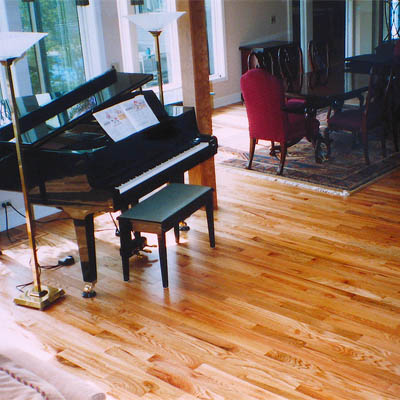Wood Floor Finishes
Wood floors made their debut in the United States during the Colonial Era. The floors were practical and functional. Aesthetics at the time were not a primary concern for the pragmatic Colonists.
During the 19th century, parquetry made its way over from the Continent and wood floors slowly became more than just planks laid down and worn down by foot traffic. Innovations like the tongue-and-groove configuration were making wood floors more versatile in both use and appearance. Protecting such quality flooring eventually become desired and necessary. The wood floor finish was born.
Today, wood floors can be found in millions of homes and settings. The floors are warm and elegant, durable and unique. Each floor is different and the finish is often what defines it. The three most common wood floor finishes are: Surface, Penetrating, and Extra-durable. Which is right for you?
Surface Finishes
Surface finishes are the most popular wood floor finishes today and though tough, require minimal care. To create the surface finish, a stain is applied to achieve a particular color, followed by a polyurethane top coat for protection. The four main surface finishes are:
- Oil-based urethane: Available in ambers, this solvent-based finish is simple to apply and dries in less than half a day.
- Water-based urethane: Clear and non-yellowing, this finish is quick to dry, only taking about two to three hours.
- Moisture-cured urethane: A solvent-based polyurethane finish that’s durable and moisture-resistant. Available in ambers, with a finish of satin or gloss.
- Conversion varnish: When dried, this finish turns amber in color. A durable finish, the conversion varnish should be applied by a professional. Not a DIY choice.

Penetrating Finishes
Penetrating finishes are wood floor finishes that actually soak into the wood. Unlike surface finishes, which sit above the wood, penetrating finishes do exactly what their name says: penetrate. After the stain soaks into the wood, a wax coating is applied.
- The sheen of a floor is its shine. Choose from a high gloss, low gloss or satin finish. Although high gloss has its advantages, it is also the finish that reveals the most scratches and imperfections. While this works for a commercial or contemporary setting, it’s not recommended for the traditional. For the home, go with the low gloss or satin.
- When it comes to maintenance, water-based products should never be used on penetrating finishes. The only acceptable care is solvent-based waxes, buffing pastes, or cleaning liquids made specifically for wax-finished wood floors.
Extra-Durable Finishes
The extra-durable finish is a newcomer to wood floors but is making a name for itself. The reason being is, its finishing process fortifies wood floors, making them “extra-durable.” The two types available are: Swedish and Acrylic.
- Swedish: As befits the name, originating from Sweden, this resin-based finish is rather remarkable in that it is so thin, the grain of the wood can still be felt. What’s more, it doesn’t require waxing.
- Acrylic: This finish is extremely hard, creating a barrier to dirt, moisture, and everyday wear. Yet because of its durability, it’s also among the most expensive and thus, more suitable for the commercial setting.